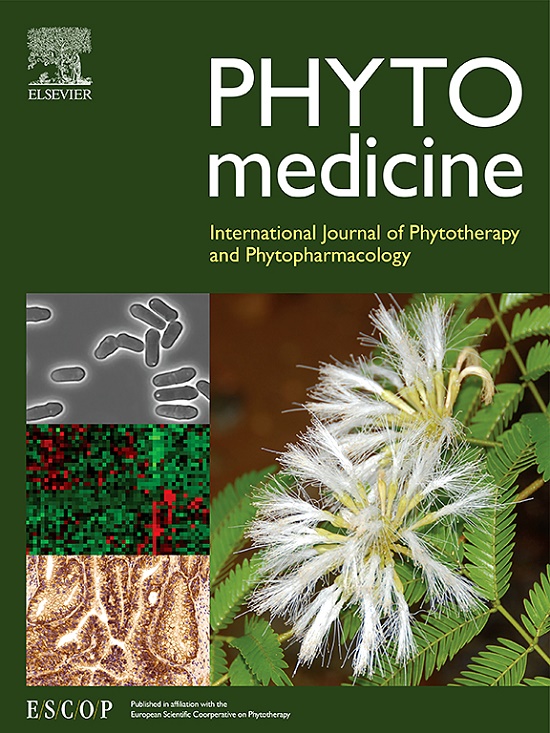五味子提取物可调节甜味受体通路、IRS/PI3K、AMPK/mTOR通路及内源性代谢物抗T2DM。
IF 6.7
1区 医学
Q1 CHEMISTRY, MEDICINAL
引用次数: 0
摘要
背景:南方五味子是五味子(Schisandra sphenanthera Rehd)干燥成熟的果实。会。木兰科;传统医学报告称,五味子具有收敛和收敛的特性,益气,促进体液的产生,镇静心灵,平静头脑;临床上用于长期咳嗽、津液伤渴、内热干渴、心悸失眠等,口渴属于糖尿病范畴;文献报道和本课组的初步研究表明,五味子具有防治糖尿病的作用。目的:通过综合药效学、内源性代谢物测定和信号通路研究SDP对T2DM的作用机制。材料与方法:采用UPLC-MS/MS进行化学成分鉴定。采用高效液相色谱法测定了八种木脂素类成分的含量。采用高脂高糖饲料与STZ联合诱导建立T2DM大鼠模型,通过生化指标、蛋白表达、mRNA表达、免疫组织化学及内源性代谢物分析,探讨SDP对T2DM的作用机制。结果:通过UPLC-MS/MS和HPLC测定了SDP的化学成分,生化指标确定SDP具有降低血糖、抗糖脂代谢、抗氧化应激的作用,能够恢复肝脏和胰腺的病理损伤,激活PI3K/AKT、AMPK/mTOR、甜味受体信号通路,恢复甜味受体mrna,调节尿中化合物如苹果酸、γ-氨基丁酸、亮氨酸、n -乙酰天冬氨酸等化合物,从而达到T2DM的治疗效果。结论:SDP可改善大鼠血糖升高、血脂异常、空腹胰岛素水平升高和糖耐量降低等糖尿病引起的症状;SDP抗t2dm可能是通过调节甜味受体通路、PI3K/AKT/mTOR和AMPK/mTOR信号通路,使其发展到正常水平,发挥降糖作用。本文章由计算机程序翻译,如有差异,请以英文原文为准。

Schisandra sphenanthera extract modulates sweet taste receptor pathway, IRS/PI3K, AMPK/mTOR pathway and endogenous metabolites against T2DM
Background
Southern Schisandra is the dried and matured fruit of Schisandra sphenanthera Rehd. et Wils. in the family of Magnoliaceae; Traditional medicine reports that Schisandra sphenanthera has astringent and astringent properties, benefiting qi and promoting the production of body fluid, tranquilising the heart and calming the mind; it is clinically utilized for prolonged cough, thirst due to injury of the body fluid, internal heat and thirst, palpitation and insomnia, etc., and thirst belongs to the category of diabetes mellitus; the literature reports and the preliminary study of our team showed that Schisandra sphenanthera can be used to prevent and control diabetes mellitus.
Purpose
In the research, we investigated the mechanism of action of SDP against T2DM by integrating pharmacodynamics, endogenous metabolite assays and signalling pathways.
Materials and methods
UPLC-MS/MS was used to identify the chemical constituents. HPLC was utilized to determine the content of eight lignan-like components in SDP. A T2DM rat model was established by the combined induction of high-fat and high-sugar feed and STZ, and the mechanism of action of SDP on T2DM was investigated by using biochemical indices, Western blot analysis of protein expression, mRNA expression, immunohistochemistry and endogenous metabolites.
Results
The chemical components in SDP were determined by UPLC-MS/MS and HPLC, and biochemical indicators determined that SDP has the effects of lowering blood glucose, anti-glycolipid metabolism, and anti-oxidative stress, and is able to restore pathological damage in the liver and pancreas, activate the PI3K/AKT, AMPK/mTOR, and sweetness receptor signalling pathways, restore the sweetness receptor mRNAs, and modulate the urinary compounds such as malic acid, γ-aminobutyric acid, leucine, N-acetylaspartic acid and other compounds thereby achieving the therapeutic effect of T2DM.
Conclusion
SDP can ameliorate diabetes-induced symptoms related to elevated blood glucose, dyslipidaemia, elevated fasting insulin levels and impaired glucose tolerance in rats; the anti-T2DM of SDP may be through the regulation of the sweet taste receptor pathway, the PI3K/AKT/mTOR and the AMPK/mTOR signalling pathway, which leads to the development of a normal level and exerts an antidiabetic effect.
求助全文
通过发布文献求助,成功后即可免费获取论文全文。
去求助
来源期刊

Phytomedicine
医学-药学
CiteScore
10.30
自引率
5.10%
发文量
670
审稿时长
91 days
期刊介绍:
Phytomedicine is a therapy-oriented journal that publishes innovative studies on the efficacy, safety, quality, and mechanisms of action of specified plant extracts, phytopharmaceuticals, and their isolated constituents. This includes clinical, pharmacological, pharmacokinetic, and toxicological studies of herbal medicinal products, preparations, and purified compounds with defined and consistent quality, ensuring reproducible pharmacological activity. Founded in 1994, Phytomedicine aims to focus and stimulate research in this field and establish internationally accepted scientific standards for pharmacological studies, proof of clinical efficacy, and safety of phytomedicines.
 求助内容:
求助内容: 应助结果提醒方式:
应助结果提醒方式:


